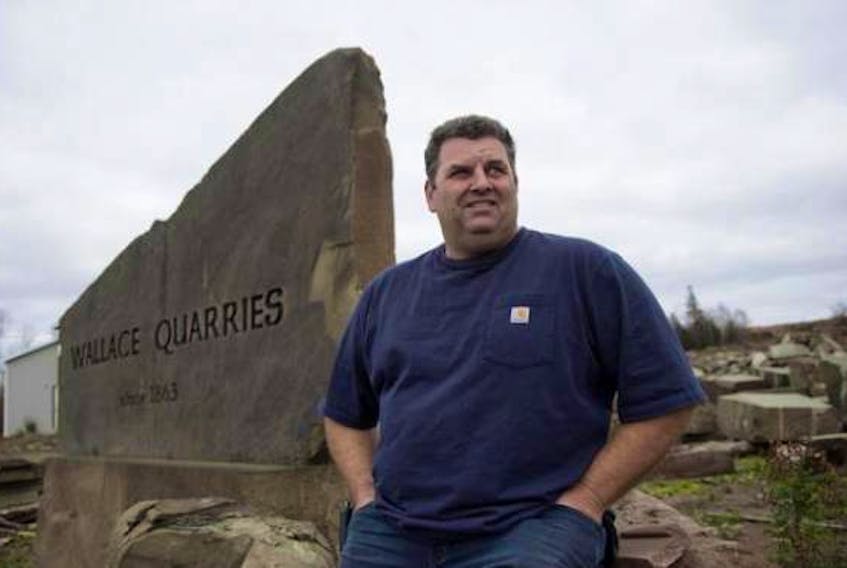When you provide 10 above-average paying jobs in a community the size of Wallace and you’ve lived there all your life, everyone knows you, even on the days you haven’t sealed the biggest business deal of your career.
So when Tom Flynn, president and owner of Wallace Quarries, arrives for lunch at McMahon’s takeout, he gets interrupted several times before he gets through his club sandwich and lemon meringue pie.
Flynn is the fourth generation of his family to work at the quarry that opened 150 years ago, and he took over ownership from his father. Flynn’s dad re-opened the quarry in the mid-1980s, after a move by builders and architects to cheaper precast concrete put sandstone out of style for two decades. But Tom is the one who negotiated the deal with Armour Group to have sandstone from Wallace clad the Queen’s Marque building now under construction on the Halifax waterfront.
“I’m 45, been here pretty much all my working life and I’ve never done anything this big,” said Flynn, who has a soft voice and a firm handshake. “We’ve sent blocks out west, but this is twice as big a deal, I’d say.”

Sandstone from Wallace covers buildings on Parliament Hill, the campuses of Dalhousie and McGill universities, and the Nova Scotia and Prince Edward Island legislatures, among hundreds of others. As many as 100 people worked in the quarry in the 19th century, when a rail spur delivered blocks of sandstone a few hundred metres down the hill to a wharf that’s still in operation.

In those days, men with mauls, now replaced by diamond-tipped saws, cut slabs of stone for delivery by ship to Halifax, Upper Canada and New England.

When the sandstone for Queen’s Marque starts being delivered next December, it’ll travel by truck. A lot of trucks.
“Approximately 22,000 square feet in panels that are three-and-a-half inches thick, one foot high by two feet long,” said Flynn. “Each of those weighs 87-and-a-half pounds, so almost two million pounds.”
The contract with Armour will provide a year’s work for the entire workforce at Wallace Quarries. Sandstone is significantly more expensive than other materials architects consider when they’re designing the exterior of buildings, but for longevity, it’s hard to beat.
“It’s been around for 150 years, and what other materials can you say that about? It’s been proven that way, we’re really lucky,” said Flynn, who doesn’t have a sales force. “A lot of the architects know the stone because they’ve been dealing with it over the years, and in Halifax, it’s all over the place down there.”
That was one of the main attractions for Armour CEO Scott McCrea, who visited three quarries before deciding on the stone from Wallace.
“The quality of that quarry, it obviously has a long history of producing rich, stable material, and because with Wallace sandstone we’re matching what is around it, it seemed the best choice from an aesthetic standpoint,” McCrea said. “Sandstone from the Maritime region is replete through downtown, whether it’s Province House, the Bank of Nova Scotia building, parts of Founders Square or the Dominion Building. It is as much a part of the history of downtown Halifax as any material, and arguably the most iconic material in downtown Halifax because it’s from the Maritimes and truly representative of the place.”
McCrea has used sandstone in other buildings but only in combination with other heritage elements, not as primary cladding. In the case of Queen’s Marque, the building will have three claddings: sandstone, glass- and copper-infused steel, with about 40 per cent of the building covered with sandstone. McCrea made the decision in collaboration with architect Brian MacKay-Lyons.
“The sandstone pays homage not only to other buildings downtown, but most particularly the Dominion Building, which sits across from it on Lower Water Street,” said McCrea. “The parapet of the Dominion Building will line up with the parapet of the Queen’s Marque, where the sandstone is. The sizing of the blocks, at two-by-one, very much matches the sizes of other blocks downtown, in particular buildings nearby. We’re trying to be contextual and it seemed like an obvious choice.”









